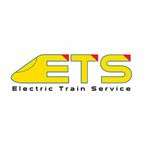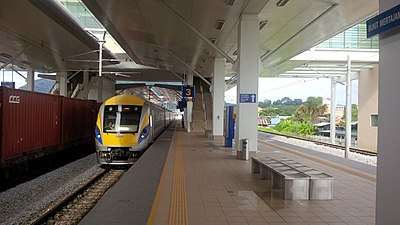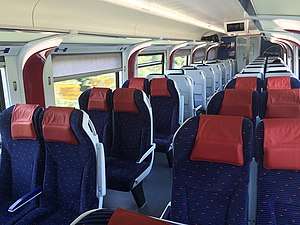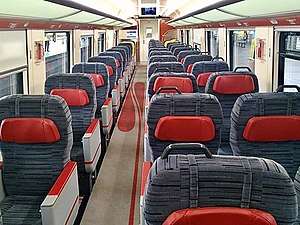KTM ETS
The KTM ETS (commercially known as ETS, short for 'Electric Train Service') is an inter-city rail passenger service operated by Keretapi Tanah Melayu (KTM) using electric multiple-unit (EMU) trains. The KTM ETS is the second electric train service to be operated by the Malaysian railway company, after the KTM Komuter service, and the second inter-city rail service, after KTM Intercity.
| KTM ETS KTM Electric Train Service | |
|---|---|
| ETS | |
.jpg) | |
| Overview | |
| Native name | Perkhidmatan Tren Elektrik (Malay) 电动列车服务 (Chinese) மின்சார ரயில் சேவை (Tamil) |
| Type | Inter-city rail - Higher-speed rail |
| Locale | Padang Besar - Butterworth - Ipoh - Kuala Lumpur - Gemas - (Johor Bahru 2022) |
| Stations | 37 (as of 2019) |
| Daily ridership | 10,489 (Third quarter 2018)[1] |
| Ridership | 4.148 million (2017) [1] |
| Website | www |
| Operation | |
| Opened | 12 August 2010 |
| Owner | Keretapi Tanah Melayu Berhad (KTMB) |
| Operator(s) | KTM Intercity Division |
| Conduction system | With Driver |
| Rolling stock | 5 six-car trainset of KTM Class 91 10 six-car trainset of KTM Class 93 |
| Technical | |
| Line length | Current: 755 km (Padang Besar-Gemas) Under construction: Additional 197 km (Gemas-Johor Bahru Sentral) |
| Track gauge | 1,000 mm (3 ft 3 3⁄8 in) metre gauge |
| Electrification | Catenary |
| Operating speed | 140 km/h (87 mph) |
KTM ETS route network | ||||||||||||||||||||||||||||||||||||||||||||||||||||||||||||||||||||||||||||||||||||||||||||||||||||||||||||||||||||||||||||||||||||||||||||||||||||||||||||||||||||||||||||||||||||||||||||||||||||||||||||||||||||||||||||||||||||||||||||||||||||||||||||||||||||||||||||||||||||||||||||||||||||||||||||||||||||||||||||||||||||||||||||||||||||||||||||||||||||||||||||||||||||||||||||||||||||||||||||||||||||||||||||||||||||||||||||||||||||||||||||||||||||||||||||||||||||||||||||||||||||||||||||||||||||||||||||||||||||||||||||||||||||||||||||||||||||||||||||||||||||
|---|---|---|---|---|---|---|---|---|---|---|---|---|---|---|---|---|---|---|---|---|---|---|---|---|---|---|---|---|---|---|---|---|---|---|---|---|---|---|---|---|---|---|---|---|---|---|---|---|---|---|---|---|---|---|---|---|---|---|---|---|---|---|---|---|---|---|---|---|---|---|---|---|---|---|---|---|---|---|---|---|---|---|---|---|---|---|---|---|---|---|---|---|---|---|---|---|---|---|---|---|---|---|---|---|---|---|---|---|---|---|---|---|---|---|---|---|---|---|---|---|---|---|---|---|---|---|---|---|---|---|---|---|---|---|---|---|---|---|---|---|---|---|---|---|---|---|---|---|---|---|---|---|---|---|---|---|---|---|---|---|---|---|---|---|---|---|---|---|---|---|---|---|---|---|---|---|---|---|---|---|---|---|---|---|---|---|---|---|---|---|---|---|---|---|---|---|---|---|---|---|---|---|---|---|---|---|---|---|---|---|---|---|---|---|---|---|---|---|---|---|---|---|---|---|---|---|---|---|---|---|---|---|---|---|---|---|---|---|---|---|---|---|---|---|---|---|---|---|---|---|---|---|---|---|---|---|---|---|---|---|---|---|---|---|---|---|---|---|---|---|---|---|---|---|---|---|---|---|---|---|---|---|---|---|---|---|---|---|---|---|---|---|---|---|---|---|---|---|---|---|---|---|---|---|---|---|---|---|---|---|---|---|---|---|---|---|---|---|---|---|---|---|---|---|---|---|---|---|---|---|---|---|---|---|---|---|---|---|---|---|---|---|---|---|---|---|---|---|---|---|---|---|---|---|---|---|---|---|---|---|---|---|---|---|---|---|---|---|---|---|---|---|---|---|---|---|---|---|---|---|---|---|---|---|---|---|---|---|---|---|---|---|---|---|---|---|---|---|---|---|---|---|---|---|---|---|---|---|---|---|---|---|---|---|---|---|---|---|---|---|---|---|---|---|---|---|---|---|---|---|---|---|---|---|---|---|---|---|---|---|---|---|---|---|---|---|---|---|---|---|---|---|---|---|---|---|---|---|---|---|---|---|---|---|---|---|---|---|---|---|---|---|---|---|---|---|---|---|---|---|---|---|---|---|---|---|---|---|---|---|---|---|---|---|---|---|---|---|---|---|---|---|---|---|---|---|---|---|---|---|---|---|---|---|---|---|---|---|---|---|---|---|---|---|---|---|---|---|---|---|---|---|---|---|---|---|---|---|---|---|---|---|---|---|---|---|---|---|---|---|---|---|---|---|---|---|---|---|---|---|---|---|---|---|
| ||||||||||||||||||||||||||||||||||||||||||||||||||||||||||||||||||||||||||||||||||||||||||||||||||||||||||||||||||||||||||||||||||||||||||||||||||||||||||||||||||||||||||||||||||||||||||||||||||||||||||||||||||||||||||||||||||||||||||||||||||||||||||||||||||||||||||||||||||||||||||||||||||||||||||||||||||||||||||||||||||||||||||||||||||||||||||||||||||||||||||||||||||||||||||||||||||||||||||||||||||||||||||||||||||||||||||||||||||||||||||||||||||||||||||||||||||||||||||||||||||||||||||||||||||||||||||||||||||||||||||||||||||||||||||||||||||||||||||||||||||||

The ETS is the fastest metre-gauge train service in Malaysia and operates along the electrified and double-tracked stretch of the West Coast Line between Gemas and Padang Besar in Peninsular Malaysia, which was previously served by KTM Intercity.
The rail service is currently operated by KTM Intercity Division. It was previously operated by ETS Sendirian Berhad, a fully owned subsidiary of Keretapi Tanah Melayu Berhad.
Train services
Routes
The ETS covers the section of the West Coast Main Line between Padang Besar on the Malaysia-Thailand border and Gemas on the border between Negeri Sembilan and Johor, including the branch line between the Bukit Mertajam Junction and Butterworth. The line from Gemas to Johor Bahru is currently a single track and is being double tracked and electrified. Most routes originate from KL Sentral, the main railway station of Kuala Lumpur, the capital city of Malaysia
The ETS operates 5 routes, namely:
- KL Sentral - Ipoh
- KL Sentral - Butterworth
- KL Sentral - Padang Besar
- Gemas - Padang Besar via KL Sentral and Ipoh
- Gemas - Butterworth via KL Sentral and Ipoh
Currently, there are 8 return trips on the KL Sentral - Ipoh route, 5 return trips on the KL Sentral - Butterworth route, 5 return trips on the KL Sentral - Padang Besar route and 1 return trip each on the Gemas - Padang Besar and Gemas - Butterworth routes daily.
The latest timetables for the routes are available on the official KTM website.
Services
The train services are operated in 3 categories:
- Platinum service with limited stops (12 return trips)
- Gold service with selected stops (5 return trips)
- Silver service with stops at all stations. (1 return trip)
- Business class service
Ridership
| KTM ETS Ridership[1][2] | |||
|---|---|---|---|
| Year | Ridership | Revenue (MYR) | Remarks |
| 2018 | 3,932,000 | N/A | |
| 2017 | 4,148,000 | 174,433,140 | |
| 2016 | 3,565,000 | 145,521,561 | |
| 2015 | 2,059,000 | 60,314,988 | |
| 2014 | 1,693,000 | 44,328,039 | |
| 2013 | 1,563,000 | 40,621,860 | |
| 2012 | 1,180,000 | 31,885,949 | |
| 2011 | 913,000 | 24,313,451 | |
| 2010 | 215,000 | 5,569,532 | Operations began in August |
History
First phase
The service was introduced by Keretapi Tanah Melayu (KTM) on 12 August 2010 between Ipoh and Seremban following the completion of the electrification and double-tracking of the Rawang to Ipoh stretch of the West Coast Line. Its inaugural run was celebrated with an opening ceremony at Kuala Lumpur railway station. Initially, services stretched southwards to Seremban, but the KL Sentral - Seremban sector was taken out of service in October 2012.[3] At launch, there were three service types—Platinum, Gold and Silver. On the fastest Platinum service, the trip was covered in two hours, one hour faster than by car. Gold and silver services had more stops, hence taking up to 2 hours 30 minutes. The route was served solely by 5 Class 91 electric trains.
Second phase

The service was extended from Ipoh to Padang Besar via Butterworth, the mainland town opposite George Town, with the introduction of the ETS Transit on 10 July 2015, with stops at 24 stations. At the inception of service, only one train service in both directions was introduced. This service was given the name ETS Transit.
On the following day on 11 July 2015, a new service called the ETS Ekspres between KL Sentral and Padang Besar, via Butterworth was introduced, which only stops at 15 stations. Again, only one service for both directions was introduced[4] although, subsequently, on 1 September 2015, an additional service between KL Sentral and Butterworth was introduced.[5] New rolling stock, the Class 93 trains, were introduced in conjunction with the extended service.
Third phase
.jpg)
On 10 October 2015, the ETS service was extended southwards from KL Sentral to Gemas with the introduction of a new service between Padang Besar and Gemas.[6] The extension of the KTM ETS service to Gemas utilizes the electrified double-track between Seremban and Gemas which was completed in 2014. This extension of service also saw the ETS service returning to Seremban after being discontinued in 2012.
Also on 10 October 2015, a new service was launched between Butterworth and Padang Besar in addition to existing services but this service was subsequently reduced in frequency and ultimately terminated, with the introduction of the new KTM Komuter Northern Sector.[7]
There were constant revisions of timetables and services as more trains became available, with more train service being added for each of the route segments. The Platinum, Gold, and Silver services were also reintroduced while the terms "ETS Ekspres" and "ETS Transit" were no longer used.
Rolling stock
| Class | Image | Cars per Set | In service | On order | Manufacturer |
|---|---|---|---|---|---|
| KTM Class 91 | 6 | 4 | N/A | Hyundai Rotem | |
| KTM Class 93 | .jpg) |
6 | 12 | 7 | CSR Zhuzhou |
First Generation
Five KTM Class 91 train sets, each comprising six cars, were purchased by KTM for $67 million (USD). The train sets were designed by the Marubeni Corporation and jointly built by Hyundai Rotem of South Korea and Mitsubishi Electric of Japan.[8] The maximum operational speed of the ETS fleet is 140 km/h but is designed to travel up to 160 km/h.[9] The total length of each train set is 138 m and weighs 231.8 tons. Each carriage is 22.95 m long, 2.75 m wide and 4 m high.[10] Each train set has a passenger seating capacity of 350 and includes on-board facilities including toilets, a buffet car, power sockets per two seats and two LED Televisions per car.
Second Generation
Nineteen sets of KTM Class 93 trains were ordered in two batches to expand the fleet as the electrified network expanded. All 19 trains are in service as of October 2019.
The rolling stock was to have been put into operation for the launch of the ETS Ekspres service between KL Sentral and Padang Besar, and the ETS Transit service between Ipoh and Padang Besar. However, reports of problems during the testing and commissioning of the train sets resulted in the then Malaysian land public transport authority, SPAD, not approving the trains for use in time for the launch of the two services on 10 July 2015 and 11 July 2015.[11] As a result, two KTM Class 91 train sets were used for the time being, one for the ETS Ekspres, and the other for the ETS Transit, allowing for just one trip in each direction for both services.
The first four KTM Class 93 sets went into service on 10 October 2015. All sets from the first batch have entered service.
The second batch differs slightly from the first, with a redesigned livery and a business class coach, a first for ETS services, and started operations with the launch of the new ETS Business Class in October 2019. These coaches were given the name Class 93/2.
Longest and fastest metre-gauge trains in the world
The ETS trains currently travel up to 140 km/h on the electrified metre gauge rail line which can be considered as higher speed rail (HrSR) based on passenger rail terminology instead of high speed rail (HSR).
The limited express train speed is comparable to Kamome and Sonic Express in Japan, the Taroko and Puyuma Express in Taiwan, and the Tilt Train service in Australia. However these services are using 1,067mm (3 ft 6 in) narrow gauge. The only similar metre gauge rail service currently operating is the Euskotren Trena, the Bilbao-Donostia inter-city rail line in northern Spain. This type of inter-state train service is very similar to KTM Komuter Northern Sector.
In view of this, there is high possibility that the KTM ETS service is the only inter-city rail line in the world with the longest route and using the 1,000 mm (3 ft 3 3⁄8 in) metre gauge at a maximum speed of 140 km/h.
On-board service

Standard Class
The seats are arranged in a 2+2 fashion and each seat comes with a tray table and a power outlet. Cluster seats with fixed tables are available on the Class 93. The seats can be easily converted for wheelchair use should the need arise. There are LCD TV screens in every coach for entertainment. Toilets are available in every coach. There are changing tables for infants on the latest Class 93/2. For Muslim passengers, there is a prayer room in every train. There is a bistro coach which sells drinks, light snacks and microwaved meals. This class is available on all trains, and is the only class available on older trains such as the Class 91 and the Class 93/1.

Business Class
The Business Class service marks a step-up from the Standard Class. In addition to the facilities already enjoyed in the Standard Class, there are additional features otherwise not seen on the Standard Class. The seats are arranged in a 2+1 configuration and are wider and able to recline up to 45 degrees. The seats can be rotated to face any direction. In addition to a power outlet, a USB port is also provided per seat. Each seat has its own on-demand video screen for in-train entertainment. Wi-Fi is complimentary for Business Class passengers. Each coach has its own steward or stewardess, whom the passengers can summon from their seats. On-board dining is included in the fare. Passengers are also given their own amenity kit. This service is only available on the Class 93/2 trains.
Proposed extensions
Gemas - JB Sentral
The MYR 8 billion contract was expected to be tendered out by the end of 2008 pending a mid-term review of the Ninth Malaysia Plan. The project would have included building over 200 km of parallel railway tracks, including stations, depots, halts, yards and bridges and cover systems such as electrification, signalling and communications.[12] This included a realignment between of the Pulau Sebang/Tampin - Gemas section.
In May 2009, Global Rail Sdn Bhd, a relatively small contractor and its Chinese partner, China Infraglobe submitted a proposal to the Government to build and upgrade tracks from Gemas to Johor Bahru at a cost of MYR 5 billion. According to them, the project would be on a private finance initiative basis and the plan submitted to the Ministry of Finance later in June 2009 was conditional upon signing over mineral rights in the state of Johor.[13]
On 29 January 2011, then Transport Minister Datuk Seri Kong Cho Ha said that the Gemas - Johor Bharu double-tracking and electrification project was expected to start that year. He added that the Government hoped to appoint the contractor for the project that year and Malaysia was still in the midst of talking with China Railway Construction, but nothing was confirmed yet. Kong said two consultants had been appointed, a design consultant and an independent checker, to monitor the project. The construction of 197 km of tracks, at an estimated cost between MYR 6 billion and MYR 7 billion, would take three years.[14]
On 27 October 2015, the public display exercise, required for all development of new railways under Section 84 of Malaysia's Land Public Transport Act 2010, for the Gemas - Johor Bahru Electrification and Double Tracking Project began and ran until 27 January 2016. According to documents on display to the public, construction is expected to begin in 2016 and be completed in 2021.[15]
The Chinese company CRCC has been awarded to carry out the Gemas - Johor Bahru Electrification and Double Tracking Project. Construction on the project began in January 2018.[16] It is expected to be completed by the end of 2021.
The length of the line to be electrified and double-tracked is 197 km between Chainage 563.040 at Gemas and Chainage 754.180 at JB Sentral. The project includes the construction of 11 stations at Segamat, Genuang, Labis, Bekok, Paloh, Kluang, Mengkibol, Rengam, Layang-Layang, Kulai and Kempas Baru, and 3 future stations at Tenang, Chamek and Senai. The upgraded line is supposed to cater for at least 22 services daily involving ETS, KTM Intercity and shuttle train services as well as the KTM Komuter.
The documents displayed also stated that the electrification for the stretch will have the same specifications as that of the Seremban-Gemas stretch, at 25 kV AC 50 Hz single phase and supplied via an overhead catenary. Train operations for this stretch will be integrated with the Train Control Centres at KL Sentral and Gemas. The designed maximum speed for the tracks is 160 km/h.
There are plans to extend the Electric Train Service lines in the future from Padang Besar to Hat Yai.
Gallery
- KTM Class 91 at Ipoh.
 Interior of the KTM Class 93
Interior of the KTM Class 93 New rolling stock, KTM Class 93.
New rolling stock, KTM Class 93.
See also
- Keretapi Tanah Melayu
- KTM Intercity and KTM ETS
- KTM West Coast Line
- KTM East Coast Line
- KTM Komuter
- KTM Intercity and KTM ETS
- Rail transport in Malaysia
- Public transport in Kuala Lumpur
References
- "Statistic for Rail Transport" (in Malay and English). Ministry of Transport, Malaysia. Retrieved 13 December 2018.
- "Transport Statistics Malaysia 2017" (PDF) (in Malay and English). Ministry of Transport, Malaysia. Retrieved 2018-09-26.
- "Recent scheduling ETS Services". KTM Intercity. Archived from the original on 26 November 2012. Retrieved 18 November 2012.
- "KL-Padang Besar electric train starts run today". The Star. 10 July 2015. Retrieved 19 July 2015. External link in
|publisher=(help) - "Kenyataan Media:Penstrukturan Jadual Waktu Tren Intercity dan ETS Bermula 1 September 2015 (Restructuring of the Timetable for Intercity dan ETS Trains beginning 1 September 2015)" (PDF). KTM Berhad. Archived from the original (PDF) on 5 September 2015. Retrieved 16 October 2015.
- "Kenyataan Media:Penstrukturan Jadual Waktu Tren Intercity dan ETS Bermula 10 Oktober 2015 (Restructuring of the Timetable for Intercity dan ETS Trains beginning 10 October 2015)" (PDF). KTM Berhad. Archived from the original (PDF) on 6 November 2015. Retrieved 16 October 2015.
- "KTM BERHAD". ktmb.com.my. Archived from the original on 2017-09-10. Retrieved 2017-09-10.
- "Marubeni Gets $67 Million Malaysia Train-Car Order, Nikkei Says". Bloomberg. Bloomberg. 26 October 2008.
- "Electric trains to reduce travel time". The Star. Central. 24 August 2010.
- "Electric Train Set". Malaya Railway.
- Meng Yew Choong (19 July 2015). "Manufacturer working hard to solve issues with new ETS sets before official handover". The Star. Kuala Lumpur. Retrieved 20 July 2015.
- Sharen Kaur (16 June 2008). "Tenders may be called". Business Times. Archived from the original on 18 June 2008. Retrieved 16 June 2008.
- Sharen Kaur (12 May 2009). "RM5b rail project on drawing board". Business Times. Archived from the original on 15 May 2009.
- "JB-Gemas railway project expected to begin this year". The Star. 29 January 2011. Archived from the original on 28 June 2011.
- All materials available for public inspection are available at http://www.mot.gov.my/my/projek-pembangunan/projek-pembangunan-rel/projek-gemas-jb%5B%5D
- https://www.malaymail.com/news/malaysia/2018/01/21/ktmb-construction-of-gemas-jb-sentral-ets-twin-tracks-begins-this-month/1559139